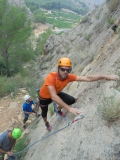Climbing is a sport that requires a lot of concentration, technique, follow the instructions to the letter. safety standards and self-confidence. Do you dare to practice it?

Climbing classes at a climbing wall
Perhaps the best option to start climbing is to go to a climbing wall where there are specialized instructors who are in charge of teaching courses, inform you of the basic material that is needed, teach you how to use all the climbing equipment and, above all and most importantly: they are responsible for explaining the rules to you of Climbing safety, something you have to keep in mind.
As at first you will not have the equipment you need, wear elastic and comfortable clothing, sports shoes that hold your foot well and if you are a girl, tie your hair up :).

From there and when you have the first class you climb a wall you will realize that more than strength it is technique. The instructor will give you the keys you will need to climb from prey to prey and will help you trust yourself.
Rock climbing trips
Only when you already have experience and have gone to the climbing gym with some regularity, will you be able to go out to the mountain with your climbing partners, as long as they have experience to be able to insure you or you go with your instructor.

Most climbing gyms periodically carry out mountain trips with their students and members, so you can sign up without any problem. Find out!
Technical tips
- It is good that at first you look for routes or blocks (the latter are not recommended when starting out, since no rope is used in them) that, although they involve effort, are easy for you. If you try to look for the most complicated thing, it is likely that you will not get out and end up getting frustrated. Little by little.
- Use your legs. You may think that it is the arms that do all the work, but it is not true: the muscles of the legs are the strongest in the body and this is the one that must send.
- Even if you want to get to a point and don't know how to do it, it is much better to try to take a detour than to want to take a step that is too long. You may not arrive, you may not make it, or you may get injured.

- If sometimes you feel blocked and don't know how to continue, try to focus on where you are, take your time and try to reposition your feet. Try not to get overwhelmed.
- Give enthusiasm and desire. It is a very fun and comforting sport, although it is also quite hard, especially in the beginning. Don't be discouraged because the effort will be worth it.
- Get used to practicing falls, because on many occasions you will fall, but if you know how to fall you can avoid injuries.
- Train your mind. Use common sense, be honest with yourself, learn to calm your nerves in situations that may get complicated and to keep a cool head.

Familiarize yourself with climbing terminology
Here is a glossary that will be useful to avoid getting stuck in the middle of a conversation between climbers:
- Paths. Let's say that it is the path that is traveled up the wall, from the ground to the meeting. A wall has several paths if there are several meetings along it.
- Meeting. In climbing it is not a meeting between colleagues, but rather it is an installation that takes place at the end of the route. At that point there will be a carabiner or directly a ring, through which, if you are the one opening the route, you will have to pass your rope. If you are not the first, you can stay calmly there for a few minutes to observe the landscape.
- Block. Wall that is climbed in a few steps, without a rope and taking a specific route. It is not very high since, when going without a rope, falls are common.

- Degrees. They measure the difficulty of the route. In Spain we are guided by the French nomenclature (7a, 6c, 8b+...) and it has its equivalent in the Anglo-Saxon system.
- Open route. It is the action performed by the first person to climb on a climbing outing. He is in charge of hooking the express belts to the track locks.
- Belayer. Person who remains at the foot of the track holding someone who is climbing the wall. It secures him by means of a grigri hooked to the harness and through which the rope.
- Plump. Protruding inclination of the rock being climbed. Depending on how steep it is, someone with a lot of experience can climb it or not.
- Cat feet. Contrary to what it may seem, it has nothing to do with the animal ;). They are special sports shoes for climbing, which adjust the foot very much and have a grippy rubber sole.
- Crash pad. Mat used to cushion falls in bouldering.

- Eight. Special knot in the shape of this number that is made to join the rope and the harness.
- Presses. They are objects made of resin that are found on the walls of climbing walls and are used to support hands and feet.
- Grigri. Safety instrument used by the person belaying to block the rope in case the partner they are belaying falls. It works even if the belayer is not paying attention.
- Magnesium. Similar to talcum powder used to prevent hands from sweating and the climber from slipping. Its use is prohibited in protected areas such as natural parks.
- Quickdraws. They are made up of two carabiners and a small ribbon that joins them.












